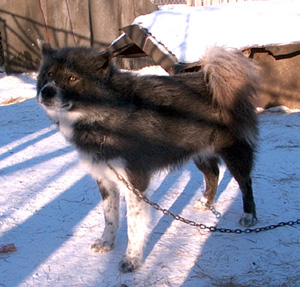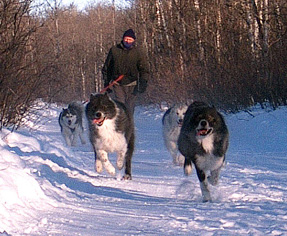Table of Contents
*
Featured Inuit Dog Owner: Brian and Linda Fredericksen
*
Lake Nipigon - Solo
*
Inuit Dogs in New Hampshire, Part II
*
The Inuit Dogs of Svalbard
*
Update: Uummannaq Children's Expedition
*
Update: Iqaluit Dog Team By-Law is Official
*
Poem: Instinct
*
The Homecoming: Epilogue
*
Product Review: Sock Sense
*
Tip for the Trail: Wet Equals Cold
*
Janice Howls: More Than Meets the Eye
*
Page from a Behaviour Notebook: Hunting
Navigating This
Site
Index of articles by subject
Index
of back issues by volume number
Search The
Fan Hitch
Articles
to download and print
Ordering
Ken MacRury's Thesis
Our
comprehensive list of resources
Talk
to The Fan
Hitch
The Fan
Hitch home page
ISDI
home page
Editor: Sue Hamilton
Webmaster: Mark Hamilton
Contents of The Fan Hitch Website and its publications are protected by international copyright laws. No photo, drawing or text may be reproduced in any form without written consent. Webmasters please note: written consent is necessary before linking this site to yours! Please forward requests to Sue Hamilton, 55 Town Line Rd., Harwinton, Connecticut 06791, USA or mail@thefanhitch.org

Cousteau
Montcombroux
photo
The Genes Don't Lie
by Geneviève Montcombroux
I've often heard people say that to take Inuit Sled Dogs out of the Arctic to raise them in the South destroys the breed. Perhaps "destroy" is too strong a word. But the allegation is that the breed is changed, and not for the better. Initially, I too held a similar view. After all, the softer climate, varied environment and alien (to the dog!) working conditions must surely contribute to changing the breed. The question is whether these changes are merely superficial or whether they alter the innate characteristics of the breed. I now believe that the fundamental qualities of the Inuit Dog are less affected by altered surroundings than some have suggested.
This observation is based in part on my experience with my own dogs at Toadhall. Even after several generations in the South, the breed's distinctive traits developed by their ancestors over thousand of years in the harsh conditions of the Canadian Arctic are as strong today as they have ever been.
Toadhall is my wooded and wetland property located in the center of the Interlake Region of Manitoba, between Lake Winnipeg Lake and Lake Manitoba. The climate is mid-continental with good snow-cover for half the year and winter temperatures which can hover as low as minus 60°F(-50°C). The prevailing wind is from the north-west and creates a significant wind-chill factor. In January and February, we can go several weeks when the temperature does not rise above 0°F(-20°C).
Summer sees a swing to the other extreme. The temperature from mid-June and mid-August frequently reaches 80-90°F(30°C), though the nights are usually cool. Toadhall is semi-wilderness land (but it does have electricity and phone). Adjacent to the property are several thousands acres of equally wild conservation land. Our dogs live in packs, in large pens cut out of the bush.
A reminder of the Inuit Dog's native instincts occurred this past winter when Michael and I took out a young team for a run along our trails. The group consisted of two females - Vercors (4 years) and Upingak (9 months) hitched to my skijoring belt. The two males - Cousteau (4 years) and his son Norsuak (18 months) were running free. Not long after setting off, I noticed that the males had parted company with us. We hurried back to the cabin and discovered that the pair had rounded up a young doe and corralled her in the yard against a clump of bushes. We promptly put the females back in their pen and I called to Cousteau - the boss dog and usually very responsive. Both dogs looked at me for a fraction second, which gave the deer time to make a dash for freedom. Cousteau and Norsuak went after her and turned the animal back into the yard. In less time that it takes to write it, they had herded the doe against the side of the cabin. Not once did they touch or harm her. I shouted. And again the distraction permitted the doe to run off, with the two dogs on her heels. Michael circled the cabin and was able to grab Norsuak and throw him inside the house. The doe saw her opportunity and ran, but Cousteau still stood between her and the trail and cut off her escape. Faced with a wolflike black dog, the deer crouched down and belled, as if having accepted to be killed. I advanced cautiously toward her and the dog, all the while talking in my "petting" voice. I feared Cousteau would go for the kill. I came within a few inches from the doe and could look her in the eye. I saw no fear, only trust. Without undue movement, I bent and took Cousteau by the collar and told the doe to run away. Of course, the words meant nothing to her, but she obviously realized I was restraining the dog. She stood up and sauntered off into the safety of the trees. Cousteau gave me an aggrieved look as though to say, "Well, I did my job. You didn't do yours."

Exercise time Montcombroux photo
What we witnessed was the dogs' hunting instinct in aid of their human companions. In traditional Inuit life, the dogs would hold the prey at bay until the master made the kill. In this instance, both dogs worked in perfect unison, while mindful to stay out of reach of the doe's hooves - as if they knew that even a yearling can pack enough punch to kill a dog or a wolf. I am sure that if it had been a polar bear those two dogs had captured, they would have reacted the same way (they've never seen a polar bear though they meet black bears regularly).
Being raised in a southern environment obviously has
changed nothing. The genes don't lie.